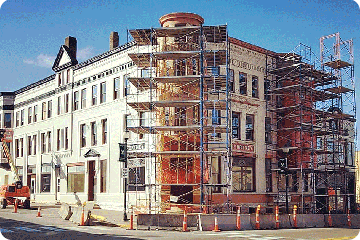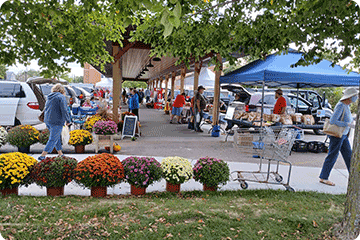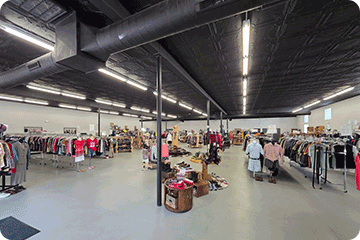
People enjoying a meal and beverage at the Driftless Café.
Strategic investments help Wisconsin communities build momentum
Strategic investments are helping Wisconsin communities to build momentum, creating a cascade of related economic development projects that fuel long-term growth and community involvement.
They are examples of the “flywheel effect,” a term coined by business strategist and author Jim Collins in his book Good to Great.
Here’s how it works: A community, using a sustained effort often beginning with a single investment, triggers a series of other developments that catalyze economic development. As with a flywheel, momentum gathers slowly—in a process that can take years—but picks up speed through related investments that produce community-changing benefits.
“Community development is where you want to start, because it attracts the workforce,” says Mike Ward, WEDC’s senior vice president of business and community development. “If it’s a place where people want to live, it will attract a workforce businesses want to locate near. And the businesses bring the tax base supporting small businesses and community institutions.”
WEDC, through the Wisconsin Main Street and Connect Communities programs, the Office of Rural Prosperity, and other programs, helps get the flywheel turning by building leadership capacity in communities. “If you don’t have that leadership and a core group of engaged people, no amount of money or policy will work,” Ward adds.
Ward says igniting community development doesn’t have to begin with a major capital outlay.
“As long as you’re doing something that’s visible, it shows you’re working together,” he says. “We’ve seen small communities do something as simple as a mural or planters. People in the community see it and want to be part of it. It builds a sense that if you can get a small project done, you can move on to larger projects.”
Turning the wheel in Viroqua
Change in Viroqua started early in the 2000s, as people moved to the Driftless region to take advantage of new educational opportunities, such as a Waldorf school. Downtown had struggled with retail vacancies and attracting tourism, but an influx of new residents brought fresh ideas, perspectives, and innovation.
Downtown vacancies dwindled. Driftless Books & Music and the Driftless Angler fly-fishing shop opened in 2004, the nationally known Driftless Café opened in 2011, and in 2017, Wonderstate Coffee transformed a 1940s Mobil gas station into a specialty coffee shop.

Restoration work on the historic Hotel Fortney in Viroqua.
Activity increased as Viroqua’s reputation grew, but challenges remained for the city of 4,500 residents. In 2020, the flywheel picked up speed when the Wrobel family bought the historic but dilapidated Hotel Fortney with an eye toward preservation and renovation.
The building consumes a half-block of Main Street and was a growing eyesore in structural disrepair.
“It’s a cornerstone of downtown,” says City Administrator Nate Torres. “Everything that’s going on here is a reflection of the human capacity of this community.”
Brian Wrobel and his family teamed up to convert the 1899 vintage three-story Queen Anne style building into first-floor commercial space and a 14-suite boutique hotel with the help of a $250,000 Community Development Investment (CDI) Grant through WEDC.
The commercial space—which is fully occupied—opened in 2021, and the hotel debuted in 2023. “Some of our commercial tenants flourished, outgrew their spaces, and moved elsewhere in the community, and that’s good to see, too,” says Wrobel.
“There was plenty here that made for a great foundation [for development]. One of the biggest points for us was having the Driftless Café right next door,” says Wrobel. “The Temple Theater, the fly fishing in the area, the art and music, they all just built on each other.”
Torres says economic development depends on strong public engagement. The city teamed with consultants and used meetings, online surveys, focus groups, and personal interviews to connect with citizens. “People are busy these days, but we’ve really thought hard about public engagement,” he says.
At the southern gateway to downtown Viroqua, local carpenter Dan Johnson is developing Round River Distilling in what used to be an auto repair and tire shop. The renovated space will include production facilities, a tasting room that also serves beer and wine, and a café. Opening is targeted for late 2025.
Johnson took a break from framing a new wall in the building to talk about Viroqua’s progress.
“I wanted to guide this little piece of Viroqua to compliment and build on everything else that’s going on in this town,” says Johnson, a homebuilder from Soldiers Grove. “There’s this strong entrepreneurial spirit here and a culture that has a connection to the organic foods movement. I saw an opportunity where I could join in the momentum in a place where I could afford commercial property.”
At the same time, a vacant Depression-era Viroqua Bath House is undergoing a $750,000 renovation—aided by a $250,000 CDI Grant, along with city and donor funding—as a new home for the Viroqua Chamber of Commerce and a welcome center. And the city received a $25,000 Vibrant Spaces Grant to create a self-guided mural walk that highlights eight original murals.
“We’ve done a lot, but we’re not done yet,” Torres says. “It’s going to be an ongoing improvement process, but I think we’ve got one of the best downtowns in the area.”
Ladysmith’s long road to success
After an F3 tornado ravaged downtown Ladysmith in 2002, community development was a necessity. Now, 22 years later, it’s a habit—one that is driving economic growth in the community of 3,200 residents.
It started with storm cleanup, talking with residents in visioning sessions, and planning for the future.
“We brought community members in, knowing we had a semi-blank slate downtown and buildings that were damaged but could be renovated,” says City Administrator Alan Christianson.
It was a slow process; in 2013, once Ladysmith joined the Wisconsin Main Street Program, the pace picked up and a spate of projects have taken root in recent years. In 2020, the city took over an abandoned grade school that had closed two years earlier; at about the same time, the federal government vacated a nearby Army Reserve Center.

Shoppers and vendors enjoy the new pavilion, which provides upgraded space for the Rusk County Farmers Market, a lively downtown attraction in Ladysmith.
Community listening sessions established housing as a priority, and the city recruited a developer to invest $14.5 million in a 40-unit affordable housing development that opened in 2025, with help from a WEDC Idle Sites Redevelopment Grant as well as other funding sources. The complex includes a community center in the old gymnasium, a new concrete skatepark, and an accessible playground—a first for Rusk County. The reserve center was transformed into a city public works facility.
The city also used a Vibrant Spaces Grant to help create a venue for the twice-weekly Rusk County Farmers Market—one with a permanent pavilion that eliminated the need for vendors to set up tents. Christianson says this project was one of the first needs identified two decades earlier in post-tornado listening sessions.
Wednesday farmers markets have tripled in the number of vendors, and the Saturday markets are 50% larger since the construction of the pavilion, says Kathy Halbur, the market’s manager.
“It gave us an opportunity to really grow,” says Halbur. “The feel of the market has changed. It’s more vibrant and has a lot more variety. And our partnership with the city grew. We now have a 20-plot community garden on property the city provided.”
The city also spearheaded renovation of an 80-year-old tornado-damaged building that stood vacant for more than two decades. With the help of a $250,000 CDI Grant, it now houses the Indianhead Community Action Agency (ICAA), its Connections Thrift Store, and the ICAA-Rusk County Food Pantry.

The Connections Thrift Store has helped boost downtown activity in a renovated space in Ladysmith.
Located across from the farmers market, the food pantry gets frequent food donations from vendors. And when the thrift store moved out of its previous headquarters, a Tractor Supply Co. store moved in.
Jennifer Shearer, CEO of ICAA, says the renovation brought vitality downtown. “There is a strong and growing sense of momentum in Ladysmith,” Shearer says. “These developments reflect a shared commitment among city leaders, community partners, and organizations like ICAA to strengthen the downtown district and create a more vibrant, connected community.”
The city capped its downtown development efforts with the $4 million rebuilding of Miner Avenue, the city’s main thoroughfare, and its underground utilities that were more than a century old. Taking note of the improvements, new businesses such as a bakery and a martial arts studio are moving in.
Sharon Reynolds, who has owned the Plaid Peacock boutique for eight years, says the momentum is encouraging. “I’m excited about it, because we needed some growth, and there is a lot more activity downtown. It’s awesome to watch the process unfold.”
Cooperative communities create economic development energy
Ward says community development attracts major employers considering relocation or expansion. “They’re looking for a community where people want to be, where people work together. That’s a large part of how you can attract big corporate players,” Ward says.
Firms such as Organic Valley in Viroqua and Henry Repeating Arms in Ladysmith, among others, are growing along with these two vibrant communities. But Viroqua and Ladysmith aren’t the only communities generating sustained economic development benefits. Many examples are spread across Wisconsin.
For example, Eagle River harnessed the power of history, culture, creativity, and entrepreneurship to help revitalize its downtown. In Ripon, downtown vacancy rates are near zero, buildings were transformed for new uses, businesses expanded, and a park was upgraded.
Many officials acknowledge there is more work to do. But that’s the point of the flywheel effect; changing a community’s long-term trajectory by building momentum in a persistent, sustainable way.
